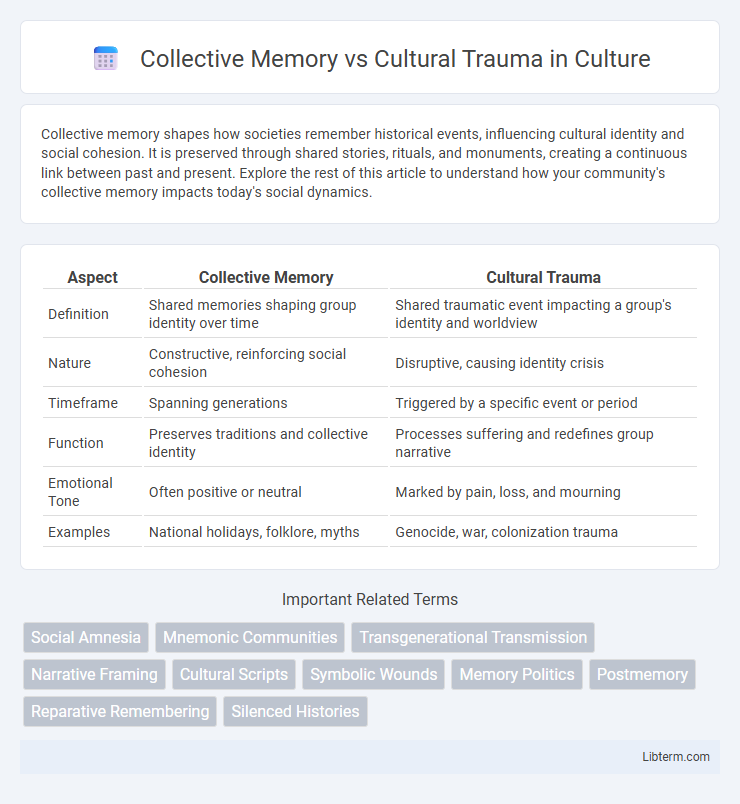Collective memory shapes how societies remember historical events, influencing cultural identity and social cohesion. It is preserved through shared stories, rituals, and monuments, creating a continuous link between past and present. Explore the rest of this article to understand how your community's collective memory impacts today's social dynamics.
Table of Comparison
| Aspect | Collective Memory | Cultural Trauma |
|---|---|---|
| Definition | Shared memories shaping group identity over time | Shared traumatic event impacting a group's identity and worldview |
| Nature | Constructive, reinforcing social cohesion | Disruptive, causing identity crisis |
| Timeframe | Spanning generations | Triggered by a specific event or period |
| Function | Preserves traditions and collective identity | Processes suffering and redefines group narrative |
| Emotional Tone | Often positive or neutral | Marked by pain, loss, and mourning |
| Examples | National holidays, folklore, myths | Genocide, war, colonization trauma |
Defining Collective Memory
Collective memory refers to the shared pool of knowledge and information held by a group that shapes their identity and understanding of the past, often transmitted through narratives, symbols, and rituals. It functions as an active, evolving process that helps communities maintain continuity across generations by selectively remembering and commemorating events. Unlike cultural trauma, which highlights disruptive experiences that fracture collective identity, collective memory encompasses both ordinary and extraordinary events that collectively sustain social cohesion.
Understanding Cultural Trauma
Cultural trauma occurs when a collective group experiences a deeply distressing event that disrupts their shared identity and history, leading to long-lasting psychological and social consequences. Unlike collective memory, which encompasses the shared recollections and narratives that bind a community, cultural trauma significantly alters these memories by framing the event as a pivotal moment of loss or suffering. Understanding cultural trauma requires analyzing how communities reconstruct their collective memory to incorporate experiences of pain, victimization, and resilience, shaping group identity and future cultural expressions.
Historical Contexts of Collective Memory
Collective memory shapes how societies remember shared past events, influencing group identity through narratives passed across generations within specific historical contexts. Cultural trauma arises when collective memory incorporates experiences of suffering or loss that disrupt social cohesion and demand meaning-making processes to integrate these events into communal identity. Understanding the historical contexts of collective memory reveals how events like wars, colonization, or social upheavals are selectively remembered or forgotten, impacting cultural trauma's formation and societal resilience.
The Formation of Cultural Trauma
The formation of cultural trauma occurs when a collective memory of a catastrophic event disrupts a group's identity and generates a shared sense of loss and victimization. This trauma is constructed through social processes where narratives, symbols, and commemorations shape the collective memory into a representation of suffering that influences future generations. Key elements in this formation include the mobilization of collective actors, symbolic framing, and the institutionalization of memory practices that embed the trauma into cultural consciousness.
Key Differences Between Collective Memory and Cultural Trauma
Collective memory refers to the shared pool of knowledge and information held by a group that shapes its identity over time, emphasizing continuity and positive identity reinforcement. Cultural trauma, however, arises from a profoundly distressing event that disrupts the collective memory, leading to a lasting sense of loss, injury, or identity crisis within the group. Key differences include the nature of impact--collective memory consolidates shared experiences and traditions, while cultural trauma marks a rupture that demands reinterpretation of identity and history.
Social Mechanisms Shaping Collective Memory
Social mechanisms shaping collective memory include storytelling, rituals, and commemorative events that reinforce shared narratives within a community. Institutions such as schools, media, and museums play critical roles in curating and transmitting collective memories, often influencing public perception and identity. Collective memory evolves through these social processes, distinguishing it from cultural trauma, which arises from collective experiences of suffering and disruption impacting group cohesion.
The Role of Narratives in Cultural Trauma
Narratives in cultural trauma function as crucial instruments for shaping collective memory, allowing communities to interpret and communicate traumatic events across generations. These narratives help construct a shared identity by embedding traumatic experiences into the cultural fabric, influencing how societies remember and respond to past atrocities. Through storytelling, rituals, and commemorations, cultural trauma narratives validate pain and resilience, fostering both social cohesion and ongoing dialogue about historical injustices.
Collective Memory in National Identity
Collective memory plays a crucial role in shaping national identity by preserving shared histories, values, and traditions that foster a sense of belonging and continuity. It involves the communal recollection of past events, often institutionalized through monuments, rituals, and education systems, reinforcing a cohesive social narrative. This collective cognition helps nations construct a unified identity while differentiating themselves from other groups, sustaining cultural heritage across generations.
Healing and Transformation After Cultural Trauma
Healing after cultural trauma involves reconstructing collective memory to acknowledge shared experiences and foster resilience within affected communities. Transformative processes utilize narrative reframing and commemorative practices to integrate painful histories, enabling societies to rebuild identity and promote social cohesion. Effective recovery emphasizes inclusive dialogue and cultural expression as catalysts for repairing fractured collective memory and facilitating long-term psychological and cultural restoration.
Intersections: When Collective Memory Becomes Cultural Trauma
Collective memory shapes how groups remember shared experiences, yet when these memories involve intense suffering or injustice, they often evolve into cultural trauma, deeply affecting group identity. The intersection occurs as collective memories embed narratives of pain and loss, transforming individual trauma into a collective wound that influences social cohesion and cultural expression. Understanding this process is key to addressing historical grievances and fostering reconciliation within affected communities.
Collective Memory Infographic

 libterm.com
libterm.com